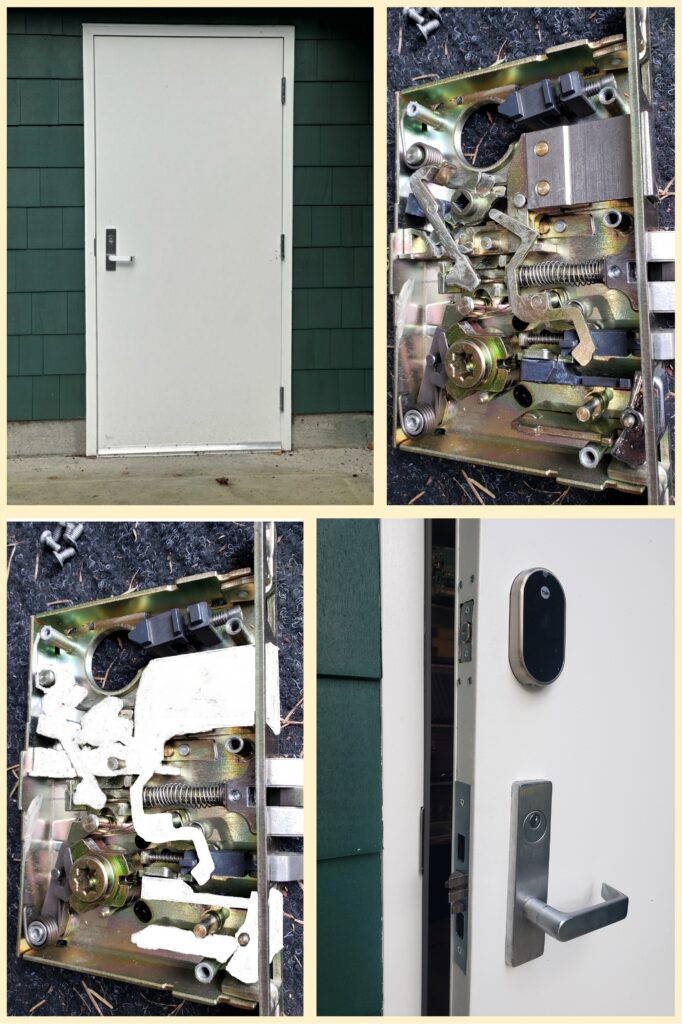I don’t exactly come out of this one smelling like roses.
Last week I had a day off and I agreed to bring a carless friend to the mall on the condition that she ride along with me for one quick job. As it sometimes goes, it turned into more than just one quick job. Halfway through it I was called by a petsitter who had locked herself out in the rain. She happened to be pretty close to the mall. I consulted with my friend and she agreed that we could squeeze in that second job before going shopping.
On the way to the petsitter lockout call, I got a text from someone whose elderly neighbor had fallen in the bathroom. They needed a locksmith to get into her house nicely rather than calling the fire department, which would surely break down the door. After getting permission to further delay our visit to the mall, I explained via text that I was en route to help someone out of the rain and that I could come right after. She said that was fine and sent me the address, which was also pretty close to where we were going.
I made quick work of the petsitter’s door and immediately called the next one to let her know I was ready to head over. She didn’t answer. I tried again. No joy. Since it wasn’t very far away, I drove to the person’s street and called the neighbor a couple more times. I looked around for activity like emergency responders or neighbors standing around looking concerned. The street was quiet. I tried the neighbor’s phone one more time to no avail, and then I drove away. Altogether this may have been a 20-minute detour. I apologized to my friend.
Ten minutes later I got a text: “Sorry I missed your calls. My phone was dead. We called another locksmith and he couldn’t get in. Could you come now?” Life is funny like that sometimes. Phone batteries die just when you think you don’t need to talk to a person and then recharge themselves when you realize you do. I understood what had happened. She wanted faster service than I was able to offer but also wanted to keep me thinking there was a job at hand in case it turned out she did need me. I was pretty unhappy about the deception and the resulting time waste. I told her that I was well on my way to another job on the other side of the county and that I wouldn’t be able to help.
In reality I was at the mall with my friend standing in line for overpriced cupcakes. Fancy cupcakes are usually more of a good-mood treat, and this episode had put me in a bad mood. I was so distracted by what had happened that I had trouble deciding what flavor of icing I wanted. And then, through my fog of bitterness, I remembered that this wasn’t just a story about a manipulative customer trying to hedge her bets with two locksmiths. At the center of it was an old person lying miserably on a bathroom floor. And to my knowledge, she was still there waiting for help. I had the ability to help but was declining to because I was mad at a neighbor for not answering my calls. This made me feel even worse. My friend saw that I was regretting this decision and encouraged me to go back and solve this problem while she shopped. But I thought it was too late to unwind my own lie about being on some other far-away job. So I stayed at the mall and helped her shop for socks. I was probably not very good company. Plus, I did not enjoy my cupcake.
Sadly, this story is representative of something I see in myself after over a decade of being a locksmith. When I first started this career I felt duty-bound to help anyone that called me, as if I were the only locksmith in King County. I loved rolling up to a house and saving the day. It barely mattered how far or how late it was. For the first few years I would usually sleep fully dressed and slumped in my chair until about 2 a.m., just in case I got a call. That way I could be out the door in moments.
It’s not like that anymore. Now I’m pretty busy for six days a week and I don’t want my evenings and days off interrupted with service calls. I try to get all the sleep I need before each day of work. Burnout is a real concern. I’ve been to thousands of lockout calls. The novelty of it wore off a long time ago and I can see that a bit of hardheartedness has crept into me. It makes me sad. And yet I think some degree of that might be necessary if I want a long career in this field. I have to draw lines and jealously guard my personal time. I can’t allow my work to be a round-the-clock commitment and crowd out everything else like it did in the early years.
Gone are the days when I could see myself as some kind of hero for hire. I frequently have trouble fitting in those emergency calls because my days are tightly scheduled with nonurgent work. I have become content with being a guy who offers a dependable service at a reasonable price, and who clocks out and unplugs when the shift whistle blows. It’s not as exciting as when I took on every emergency call that came my way, but it leaves room for other sources of fulfillment. I hope to use my personal time to enjoy my own life and build good relationships. Maybe someday when I’m old I’ll fall in my bathroom and there will be a neighbor whom I’ve had the time to get to know, and who will care enough to call a locksmith for me.

 Commercial
Commercial 






